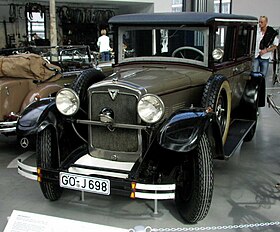Adler Standard 6
| Adler Standard 6 | |
|---|---|

Adler Standard 6S 1928
|
|
| Overview | |
| Manufacturer | Adlerwerke |
| Also called | Adler Standard 6 10/45 Adler Standard 6 12/50 Adler Standard 6 (3U) |
| Production | 1927 – March 1934 21,249 units |
| Assembly | Frankfurt am Main |
| Designer | Prof. Dr. Ing. Gabriel Becker |
| Body and chassis | |
| Body style | “Pullman Limousine” (“six-light 4 door saloon) Various coach built bodies supplied in relatively small numbers by a number of coach builders. |
| Layout | FR layout |
| Powertrain | |
| Engine | 1927 - 1926 2,540 cc 6 cylinder in-line 1928 - 1934 2,916 cc 6 cylinder in-line |
| Transmission | 1927 – 1934 3-speed manual 1933 - 1934 4-speed manual with lockable freewheel (new bodied “3U” model only) |
| Dimensions | |
| Wheelbase | 1927 - 1933 2,840 mm (112 in) or 3,140 mm (124 in) 1933 - 1934 3,200 mm (130 in) (new bodied “3U” model) |
| Length | 1927 - 1933 4,270 mm (168 in) (standard bodied cars) 1933 - 1934 4,750 mm (187 in) (new bodied “3U” model) |
| Width | 1927 - 1933 1,650 mm (65 in) 1933 - 1934 1,740 mm (69 in) (new bodied “3U” model) |
| Height | 1927 - 1933 1,825 mm (71.9 in) 1933 - 1934 1,650 mm (65 in) (new bodied “3U” model) |
| Chronology | |
| Successor | Adler Diplomat 12/60 |
The Adler Standard 6 was the most important newcomer at the Berlin Motor Show in October 1926. It was a substantial six cylinder “limousine” (saloon) built by the Frankfurt auto-maker, Adler. Other body styles were available from coach builders. The model continued to be produced until 1934.
The Standard 6 shared its wheel base with the less expensive four cylinder Adler Favorit which appeared early in 1929. The Standard 6 was also in most respects the blueprint for the longer more powerful eight cylinder engined Adler Standard 8 which arrived in 1928.
The basic architecture of the car with its rigid axles, high body and "overslung" chassis was in essence copied from Chrysler . One result of this was that the Adler Standard 6 was the first volume-produced German car able to compete effectively with the Chryslers which in the 1920s competed powerfully with Germany’s domestic auto-makers in this class. Brakes operated on all four wheels and were hydraulically controlled, which again, was seen as reflecting US influence on Gabriel Becker, the car’s Berlin-based designer.
According to Oswald Becker also imported some of the North American auto industry’s less commendable aspects, including a very imprecise steering mechanism and, in the early models, engines that lasted only for about 17,000 km (11,500 miles). However, the Adler technicians worked on what turned out to be teething troubles, and soon the Adler Standard 6 became a favourite with the German upper middle class and with taxi operators.
Following its motor show launch in October 1926, volume production of the Adler Standard 6 got under way during the early part of 1927.
The six cylinder side-valve 2,540 cc engine drove the rear wheels through a three speed gear box and provided a claimed maximum output of 45 PS (33 kW; 44 hp) at 3,000 rpm. The figures 10/45 in the car’s name referred respectively to the Tax horsepower (on which car tax was based till 1928) and actual horsepower in PS (i.e. applying the German standard formula).
The car was offered with a standard wheelbase of 2,840 mm (112 in) or a longer wheelbase of 3,140 mm (124 in). The Shorter wheelbase Standard 6N continued as the entry level model until 1930, but the longer wheel base ceased to be available with the 6N’s engine before the end of 1928. The standard body was made from steel which at this time was a common feature on North American cars but still unusual in Europe.
...
Wikipedia
